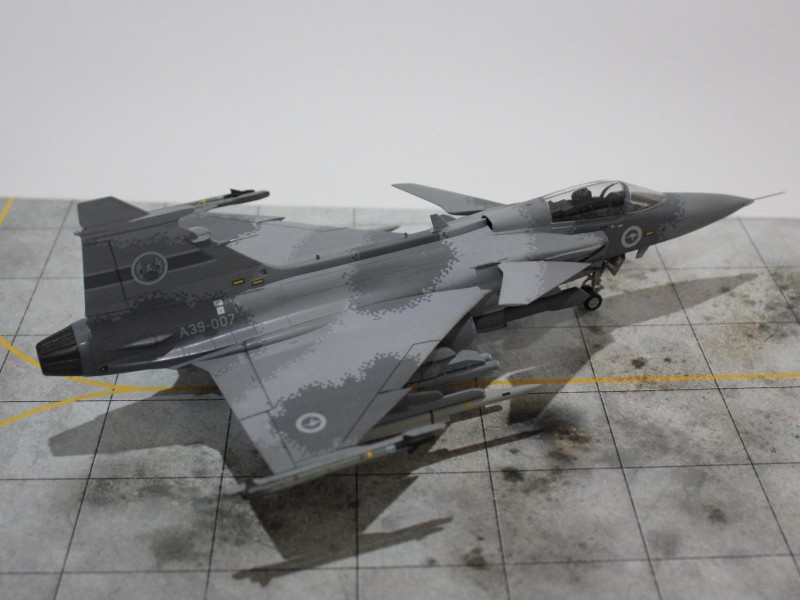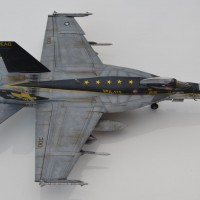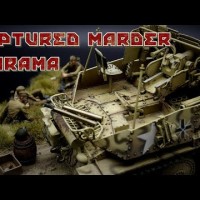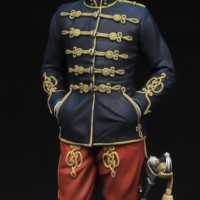What if… RAAF JAS-39 Gripen
This article is part of a series:
Subject
This is the first in a series of ‘what if' aircraft that I'm building.
In 1999 the Australian Department of Defence announced Project AIR 6000 "New Air Combat Capability (NACC)", which was intended to find a replacement for the air combat capability provided by both the 71 F/A-18A/B and 35 F-111C/G then in service. The F/A-18 provided air combat, strike and close air support capabilities, while the F-111 provided long range strike, reconnaissance and maritime strike capabilities to the RAAF. AIR 6000 sought to find a single platform that was able to undertake all of these missions.
Expressions of interest were sought from major aircraft manufacturers in Europe and the US and an eventual 9 contenders were under consideration.
Alphabetically, these were:
- Boeing F/A-18E/F Super Hornet
- Boeing F-15E Strike Eagle
- Dassault Rafale
- Eurofighter Typhoon
- Lockheed Martin F-16E/F Desert Falcon
- Lockheed Martin F-22 Raptor
- Lockheed Martin F-35 Lightning II
- SAAB JAS-39 Gripen
- Sukhoi Su-27/30/35 Flanker
In June 2002 Australia joined the Joint Strike Fighter (JSF) development program and announced that the Lockheed Martin F-35 would be the solution to AIR 6000, provided that the final design met the RAAF needs and budget.
In the mid 2000's I decided I would build all of these "AIR 6000" jets and this is the first one I've completed. It is my interpretation of what a RAAF Gripen might have looked like, had it been chosen instead of the F-35.
In my personal ranking, I put the Gripen as seventh out of the nine contenders. While it is a very capable aircraft, and reportedly cheap to operate, it's small size limits it's range. With a major requirement being the defence of our northern approaches, range is a critical performance measure. Australia is approximately the size of continental USA, with long distances between air bases, and the rest of the world is a long way away.
ADF aircraft are assigned a serial number starting with the prefix "A", then a type number followed by an individual aircraft number. As the F-35 has been allocated the type number A35, I decided that the JAS-39 should be allocated A39, and, as I rank this aircraft a seventh, the full serial is A39-007.
79 SQN RAAF was established in 1943 with Spitfires for the defence of Australia against the Japanese, being deactivated in November 1945. It was reactivated in 1962, operating CAC Sabres from Ubon Air Base in Thiland, before being deactivated again in 1968. It was reactivated at RAAF Base Butterworth, Malaysia, in 1986 to operate Dassault Mirage IIIO while other squadrons transitioned to the F/A-18 Hornet, before being disbanded again in 1988. Its final reactivation occurred in 1989 as a fast-jet transition squadron operating Aermacchi MB-326s. It currently operates Hawk 127s. Due to the squadron's history of repeated activation/deactivation, the squadron crest features a Phoenix.
As the Gripen (Griffon) is also a mythical creature, I decided my Gripen should belong to 79 SQN.
Construction
This kit dates back to 2005 and I bought it on a trip to the UK in 2006.
The external shape of the kit is quite good - that is it looks like a Gripen - but the cockpit is overly simplistic and looks nothing like the real thing. So, I purchased the CMK update set that brings it up to JAS-39C standard. The set principally includes resin replacement for the cockpit and ejection seat, plus an inflight refuelling probe, various antenna blades and pitot tube plus a vacu-form canopy and photo-etch details.
I cut away the necessary cockpit parts to fit the update set and glued the fuselage halves together to see how they fitted. I also glued the upper wing surfaces to the lower single piece to see how they fitted to the fuselage.
And that is where I left it for a decade or so...
In 2018 I decided that his would be my entry in my model club's annual "gunna build/gunna finish" competition, but I didn't quite finish the kit for in time (98% complete).
I decided I would arm my Gripen with Meteor and AIM-9X missiles plus GBU-53 small diameter bombs (SDB II). The Meteors were scratch built using the AMRAAMs from the Revell Eurofighter Typhoon and basing them on the Meteors from the same kit. The AIM-9Xs on the wingtips were sourced from the Kinetic F/A-18 kit and the GBU-53 SDB IIs and BRU-61 bomb carriage system come from the Meng F-35A kit.
Maestro Models produces a resin set of NATO outer pylons with BOP/B & MML rails with BOL for the JAS-39 Gripen. The rear of the pylon includes the BOP/B with 6 circular flare/chaff slots and the MML rail has the BOL flare/chaff dispenser at the back. I used these to mount the Meteors under the outer wing.
To round thing out, I mounted an AAQ-33 Sniper XR targeting pod on the pylon under the starboard intake. This also came from the Kinetic F/A-18 kit.
Colours and Markings
As this is a what-if build I had no constraints on the colour scheme.
My original thoughts were to apply a four-greys scheme along the lines of the early SAAB Viggen multi-green camouflage. I picked up a brochure from the SAAB stand at the Australian International Air Show one year that featured the JAS 39E/F proposal for the Danish Air Force with a paint scheme similar to the one I was thinking of. But then I decided that would take too much effort to mask for painting, particularly as it would require the full pattern to be worked out and then cut in order to ensure that the scheme was consistent over all the aircraft surfaces.
So, I decided on a three colour, all over camouflage pattern with soft, freehand demarcations and began to map out schemes on my computer. I decided to do a three-grey wrap around scheme but with darker colours dominating the top and the lighter grey dominating the under surfaces.
But, then I had another idea. I would mask and paint a 'digital' camouflage version of my three-grey scheme - how hard could that be?
I first painted the aircraft the middle grey (Gunze H317 FS 36231) and then sprayed slightly over large areas of the dark grey (Gunze 305 FS 36118). When dry, I masked the dark grey with large rectangles using 6 mm Tamiya tape, leaving a border of dark grey. I then cut more tape into 2 mm x 2 mm squares and applied these around the masked areas to give a "digital" effect. I then sprayed the light grey (Gunze 308 FS 36375) areas and repeated the masking process over this colour. The remaining unmasked areas were then resprayed the middle grey and masks removed.
I also painted a false canopy on the underside of the fuselage using Tamiya XF69 NATO Black, which is a very, very dark grey.
After I'd finished this scheme I found pictures of the proposed 'Sea Gripen' which had a strikingly similar camouflage, including the false canopy.
The national insignia and aircraft numbers were sourced from Aussie Decals sets while the formation strips and some of the stencils came from the kit decals. Other stencils were sourced from the Kinetic F/A-18 kit, as were the AIM-9X decals.
The 79 Sqn low viz. squadron insignia was sourced from the Caracal Mirage decal set. These featured a horizontal dark grey stripe with light grey pin stripes with a circular squadron badge inset. However, the port side had a cut-out in the stripe to allow for the Mirage rudder control fairing. Rather than try and paint match for this I decided to mask the background for the squadron insignia and then mask and spray on the stripes. I then cut out the squadron insignia from the decal and applied that to the tail.
After an early start, this kit spent a long time on the shelf before I picked it up again and completed it.
I'm glad I got energised again and I'm very happy with the way it turned out, particularly the camouflage scheme.
I'm currently finishing off my second 'Air 6000 Jet', a Dassault Rafale B which has also spent a bit of time on the shelf waiting to be finished. I'm going to make sure build the rest of the set before too long.

















Mate, that masking session looks brutal. Very nice model and sounds like a great project. Will you go all grey camou on all or will we see a bit more colourful machines aa well?
G'day Stellan,
It was about the time that I took the first photo of the masking that was starting to regret the idea. Cutting tape into 1mm x 1mm squares and then placing them on the kit gets pretty tedious. Still I'm happy with the effect - although next time (no, there won't be one) I'd make the larger masked areas less 'blocky' (as for the dark grey on top of the starboard wing).
There is not much colour on modern jets, although I have plans for a bit of colour on the Su-35 (I just picked up the G.W.H kit and that might be next in line).
These days the 'colour' comes from the different weapons options.
I agree with Stellan on the masking, but worth the effort! Made a stunning model.
G'day Greg,
Thanks for the comment.
A cool looking build!
G'day Robert,
Thanks, too.
Fantastic model Michael!
Looks awesome.
G'day Michael,
Thanks.
The Rafale should be done soon, too.
Love the scheme, nice work.
G'day Ray,
Thanks.
Wow, nice work! and that painting camo... I thought is was decal
congratulations